-
Posts
3,132 -
Joined
-
Last visited
Content Type
Profiles
Forums
Gallery
Events
Posts posted by trippwj
-
-
26 minutes ago, tomsimon said:
Are these 2 books the same content? Thanks
1. Seventeenth Century Rigging by R.C.Anderson2. The Rigging Of Ships: In The Days Of The Spritsail Topmast, 1600-1720, Anderson, R.C.
thanks.
Seventeenth Century Rigging is an update (1955) to the 1927 Rigging of ships. Very similar content wise.
Anderson was one of the authorities. Check the "Mariners Mirror" for some of his work.
-
Anderson is very good though a bit more of a narrative. Lees is also very good.
For the time period of interest there aren't many other good modern works, and not that many contemporary works. I'll check my files tomorrow and see what I can find.
-
As my significantly better half (to refer to her as the Admiral would be a demotion of sorts) has noted, effective transcriptionating is as much as arte as a science. In some of her endeavors she has found that the same writer in the same paragraph can offer multiple spellings for the same word. The most pleasurable items to transcribe are those copied into a letterbook by clerks or scribes - they tended to have much cleaner script and few ink smears or scratchouts!
As but one example, here is a page from Joshua Humphreys workbook - likely NOT written by a scribe but possibly by Humphreys.
And here is one from the War Department Letterbook, copied into the book by a clerk.
- Keith Black, mtaylor, druxey and 2 others
-
 5
5
-
On 1/14/2021 at 4:21 AM, Mark P said:
I will look into the possible sources which Harvey gives, so thanks again for posting these. Incidentally, a William Bourne (if my memory is not playing me false) was accused by Matthew Baker, the leading Elizabethan shipwright, of attempting to steal Baker's design work and pass it off as his own. So the possibility of Bourne (if this is the same person, of course) actually being more of a gunner is rather interesting.
It is also possible that the meaning of the word 'regiment' in the modern reprint would actually be clearer if it was changed to 'regimen', which has a different meaning, but which may well be what Bourne was intending to impart to his potential readers of a work on navigation, not fighting.
All the best,
Mark P
It is indeed the same Bourne. He also had a few other interesting treatises over the years.
Bourne, William. 1578a. A Booke Called the Treasure for Traveilers : Devided into Five Bookes or Partes, Contaynyng Very Necessary Matters, for All Sortes of Travailers, Eyther by Sea or by Lande. Imprinted at London : [By Thomas Dawson] for Thomas Woodcocke, dwelling in Paules Churchyarde, at the sygne of the blacke beare. http://archive.org/details/bookecalledtreas00bour.———. 1578b. Inuentions or Deuises : Very Necessary for All Generalles and Captaines. http://echo.mpiwg-berlin.mpg.de/ECHOdocuView?url=%2Fmpiwg%2Fonline%2Fpermanent%2Flibrary%2FEK71UE84%2Findex.meta&viewMode=index&mode=texttool&viewLayer=extended.———. 1601. A Regiment for the Sea. Contayning Very Necessarie Matters for All Sorts of Men and Trauailers: Whereunto Is Added an Hydrographicall Discourse Touching the Fiue Seuerall Passages into Cattay. Written by William Borne. Newly Corrected and Amended by Tho. Hood, D. in Physicke, Who Hath Added a New Regiment for the Yeare 1600, and Three Yeares Following, and a Table of Declination. Whereunto Is Also Adioyned The Mariners Guide, with a Perfect Sea Carde by the Said Thomas Hood. Printed by T. Wight. http://brbl-dl.library.yale.edu/vufind/Record/3444832.Bourne, William. 1587. The Arte of Shooting in Great Ordnaunce Contayning Very Necessary Matters for All Sortes of Seruitoures Eyther by Sea or by Lande. https://quod.lib.umich.edu/cgi/t/text/text-idx?c=eebo;idno=A16508.0001.001.- Harvey Golden and mtaylor
-
 2
2
-
-
7 minutes ago, noel_colledge said:
Would the Salinity of the sea at departure and destination also have a bearing on the amount of ballast taken on board, especially if travelling over the equator.
At most a minor impact for a loaded vessel (an inch or so perhaps) - far less than the consumption of food & water.
- thibaultron, noel_colledge and mtaylor
-
 3
3
-
Here is a start for you - there are scores more, as well as numerous other resources such as the Navy Documents series (look for Barbary Wars, Quasi War with France, War of 1812 here http://www.ibiblio.org/anrs/c19.html).
Byington, Richard Brownlow. 2015. “Cut from Different Cloth: The USS Constitution and the American Frigate Fleet.” Doctor of Philosophy, Florida State University. http://fsu.digital.flvc.org/islandora/object/fsu%3A291267/.
Chapelle, Howard I. 1944. The American Sailing Navy: The Ships and Their Development. S.l.: Bonanza.
Chapelle, Howard I. 1967. The Search for Speed under Sail, 1700-1855. New York: Norton.
Eriksen, Olof A. 2009. Constitution: All Sails up and Flying. Denver, Colo: Outskirts Press, Inc.
Hollis, Ira N. (Ira Nelson). 1900. The Frigate Constitution; the Central Figure of the Navy under Sail. Houghton, Mifflin. http://archive.org/details/frigateconstitution00hollrich.
Jennings, John. 1966. Tattered Ensign. The Story of America’s Most Famous Fighting Frigate, U.S.S. Constitution. New York: Thomas Y. Crowell Company.
Marquardt, Karl Heinz. 2005. The 44-Gun Frigate USS Constitution: “Old Ironsides.” Anatomy of the Ship. Annapolis, Md: Naval Institute Press.
Martin, Tyrone G. 1997. “A Loved and Respected Machine.” Naval History 11 (4 (Jul/Aug)): 26–56.
Martin, Tyrone G. 2003. A Most Fortunate Ship: A Narrative History of Old Ironsides. Annapolis, Md.: Naval Institute Press.
Norton, Louis Arthur. 2013. “Timber for America’s Wooden Walls.” Naval History 27 (2): 58–63.
Roosevelt, Franklin D. 1914. “Our First Frigates. Some Unpublished Facts About Their Construction.” Transactions of the Society of Naval Architects and Marine Engineers XXII: 139–55.
Toll, Ian W. 2006. Six Frigates: The Epic History of the Founding of the U.S. Navy. 1ST edition. New York: W. W. Norton.
-
9 hours ago, J T Lombard said:
I am looking for good reference books on the USS Constitution. Any suggestions???
regards
J Lombard
Career or construction?
For the former there are hundreds (I might exagerate) and for the latter dozens.
I'll see what I can pull together but suggest starting with The Six Frigates by Toll, if only for the bibliography!
-
2 minutes ago, Bill97 said:
Ok Gregory thanks. So the paper clip technique would not work if I decided to make the deadeye parts in advance off the ship because I would not be tying them to the channel or shrouds yet, right? Again I am getting educated here. As Justin said above it may be an advantage for me to purchase a book.
The advantage to rigging on the model is that you can adjust the tension as necessary. If you are off in your measurement rigging off the model you need to retension when you install and, with the ratlines already strung that is extremely labor intensive.
The tying of all those ratlines is for many one of the more tedious activities. Once the shouds are installed and appropriately tensioned on the model it is just a matter of tying off a whole bunch of clove hitches at appropriate distance to put on the rats.
You can use the paperclip method on or off the model as it is just to establish the spacing.
There are many books that can be of use - zu Mondfeld is a good choice.
Is HMS Victory your first model?
-
The shrouds actually are not looped around the mast and down in "real" practice but rather have a loop at the top which slips over the masthead as in the drawing below (from Peterson)
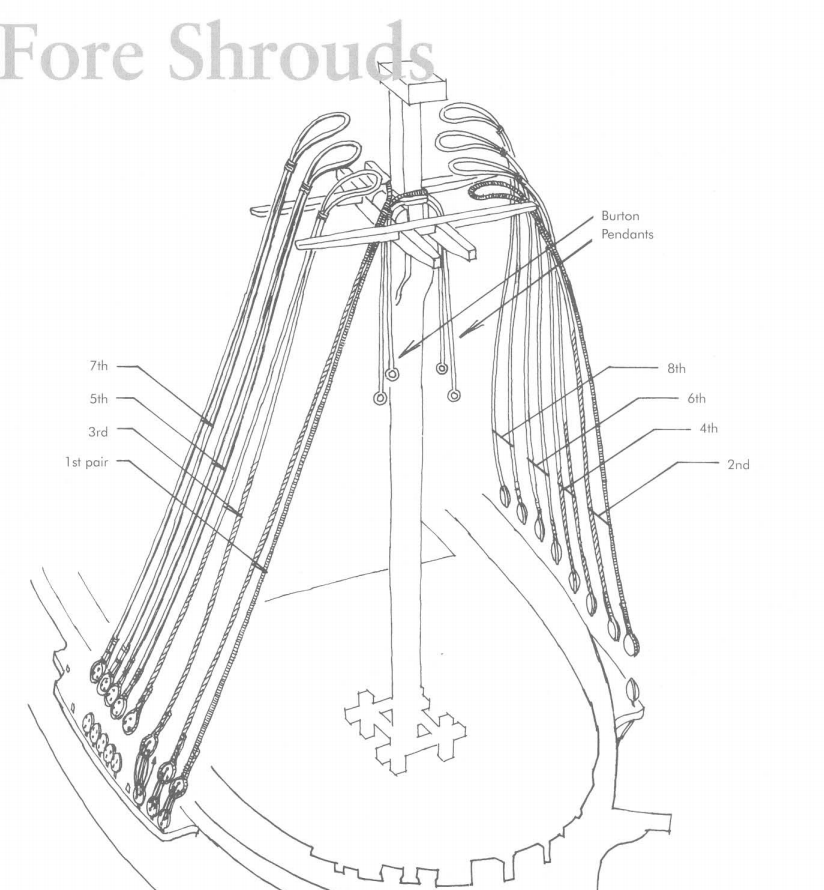
In the example above, each is a doube shroud with a seized "eye" at the top. In many cases, there is only a single shroud (that is, it terminates in a loop at the top and a deadeye at the bottom). Gets confusing, huh?
Each shroud goes to a deadeye as shown below:
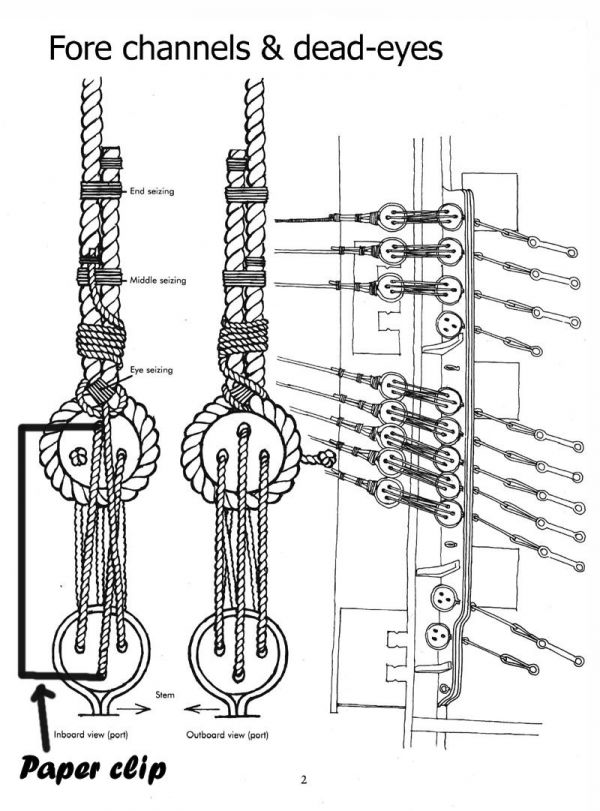

Doing it this way allows each shroud (which hold mast vertical) for appropriate tension. Looping down not only requires an even number of shrouds as you noted but also could create unequal tension resulting in the model mast shifting.
-
Finding a good copy of Sutherland has always been difficult. The ECHO – Cultural Heritage Online website has his 1711 and 1717 editions in images (tedious, but if someone really was bored each image can be downloaded and assembled into the final book). I don't recall if the plates were present in these versions.
I have found the 1748 edition on Google Books, however it suffers the same issues as most of the digitized volumes with fold out plates distorted or not scanned in full.
Sutherland, William. 1748. Marine Architecture: Or, the Ship-Builder’s Assistant: Containing Directions for Carrying on a Ship, from the First Laying of the Keel, to Her Actual Going to Sea, Etc. [With a Folding Plate.]. W. & J. Mount & T. Page. https://books.google.com/books?id=57BWAAAAcAAJ.There have been a few reprints made during the 1980"s and 90's and a few "print on demand" versions which are difficult to use (printed to smal size rather than original size, and plates also greatly reduced).
Bruzelius (see topic on his site) has some extracts from Sutherland which may be useful, and there was an interesting article some years back in The Northern Mariner looking at developing the drawings for a ship based on Sutherland (
Kenchington, Trevor John. 1993. “The Structures of English Wooden Ships: William Sutherland’s Ship, circa 1710.” The Northern Mariner 3 (1): 1–43.Lastly, for those interested, the Mariner's Mirror had an article about Sutherland which may be of interest.Mallagh, Cris. 2014. “Some Aspects of the Life and Career of William Sutherland.” The Mariner’s Mirror 100 (1): 17–28. https://doi.org/10.1080/00253359.2014.866372. -
Thanks - I purchased the Cain book today on that site named for a river (under $12 with shipping). I actually have a PDF copy of Crisman's Coffins of the Brave (available at his page on Academia.edu).
I have done a fairly deep dive seeking more but it appears most are only in unpublished manuscript form at the Hamilton Scourge website, which is woefully uninformative. I was able to obtain the 2009 ACUA Underwater Archaeology Proceedings via their website (free pdf).
i may be able to glean some info from that as there are several articles listed in Crisman. I'll keep you posted if I can find anything.
- mtaylor and uss frolick
-
 2
2
-
2 hours ago, uss frolick said:
Hey Wayne, Can you find any papers or any technical archeological articles on the 1813 Lake Ontario wrecks of the US Schooners Hamilton and Scourge? I mean, other than the books "Ghost Ships" and "Coffins of the Brave", and that National Geographic article from the 1980's?
It is getting a tad late so I must absent myself from the computer for the evening. Will continue the search in the morning. Let me leave you, though, with a couple of teasers.
First, a "virtual tour". http://1812tour.hamilton.ca/hamilton_scourge.html
There are an impressive number of photographs apparently available through the project. It appears that Brandy Lockhart of Parks Canada may be the "go to" person.
Lockhart, Brandy M., Jonathan Moore and Robert Clarke, 2009 New Insights into the Nautical Archaeology of the Hamilton and Scourge. ACUA
Underwater Archaeology Proceedings 2009, Erika Laanela and Jonathan Moore, editors, pp. 173-180. Advisory Council on Underwater Archaeology.
Also see the information in the attached thesis extract.
Kopp, Nadine. 2012. “The Influence of the War of 1812 on Great Lakes Shipbuilding.” MA Thesis, East Carolina Univeristy. https://thescholarship.ecu.edu/handle/10342/3839.Extracted pages from Kopp_ecu_0600M_10625.pdf
This next one offers little new, but may provide an additional contact.
McAllister, Michael. 2009. “Museum under the Waves: Preserving and Interpreting the Hamilton and Scourge National Historic Site of Canada.” In ACUA Underwater Archaeology Proceedings, 2009. https://www.researchgate.net/publication/323704276_McAllister_-_Museum_091201.I am debating on purchasing the books by Crisman and Cain - any advice, Stephen?
Ps. It was interesting to see your description of the Wasp/Reindeer engagement compared to that offered by TR. Rather flattering, eh?
Crawford, Michael J. 2002. “The Lasting Influence of Theodore Roosevelt’s Naval War of 1812.” International Journal of Naval History 1 (1). http://www.ijnhonline.org/wp-content/uploads/2012/01/pdf_crawford.pdf. Footnote #9. -
27 minutes ago, kurtvd19 said:
Check the TAMU site too. They have done stuff in the Great Lakes and Lake Champlain (the 6th Great Lake)
Kevin Crisman of TAMU is Author of "Coffins of the Brave" .
Here are the 2 books Sir Frolick mentioned:
Cain, Emily. 1983. Ghost Ships: Hamilton and Scourge : Historical Treasures from the War of 1812. Toronto; New York: Musson ; Beaufort Books.Crisman, Kevin James, ed. 2014. Coffins of the Brave: Lake Shipwrecks of the War of 1812. First edition. Ed Rachal Foundation Nautical Archaeology Series in Association with the Institute of Nautical Archaeology and the Center for Maritime Archaeology and Conservation. College Station: Texas A&M University Press. https://www.academia.edu/9802517/Coffins_of_the_Brave_-_Introduction.- uss frolick and mtaylor
-
 1
1
-
 1
1
-
1 hour ago, uss frolick said:
Hey Wayne, Can you find any papers or any technical archeological articles on the 1813 Lake Ontario wrecks of the US Schooners Hamilton and Scourge? I mean, other than the books "Ghost Ships" and "Coffins of the Brave", and that National Geographic article from the 1980's?
I shall dig into my files and see what leads I can find.
-
Check with your local library to see what they use.
- Canute, Rik Thistle and mtaylor
-
 3
3
-
17 hours ago, mangulator63 said:
This subject may be discussed elsewhere and if so I apologize.
With that said, I am thinking of modeling the Emma C. Berry from scratch in a scale of 1/2" = 1' or 3/4" = 1' I plan on using Model Shipways ECB kit plans that are scaled at 3/8" = 1'. Unfortunately they have no information on the construction methods used in her original build.
I am trying to figure out some details on how the ship was originally constructed back in 1866. First I am trying to figure out if she was put together using iron bolts for the framing or trunnels ? Was her planking installed with bolts or trunnels ?
From the few images of her I have found on the internet ,I was able to see that the knee bracing was attached to the deck framing with what appear to be iron bolts. I was not able see any framing detail as far as joints. I also wonder if the bolts I did see were possibly from restorations or modification she may have recieved over the years. I also wonder how the frames themselves were were constructed.
I wish to model her in a larger scale so I can get into modeling in the finer details.
I would appreciate any help I can get.
Thanks All,
Tim
There may be some information in the following which documents the restoration of the ECB in 1969
Ansel, Willits Dyer. 1973. Restoration of the Smack Emma C. Berry at Mystic Seaport, 1969-1971. Mystic, Conn: Marine Historical Association. ISBN 978-0-913372-08-1 -
While perusing the available theses at the East Carolina University (as I am wont to do on occasion), I came across these three which, individually, may appeal to some of you.
Brenkle, Matthew P. 2004. “Blue Jackets and White Trousers: British and American Sailor Clothing, 1750-1815.” Thesis, East Carolina University. https://thescholarship.ecu.edu/handle/10342/6615.Green, Catherine M. 2003. “Nineteenth-Century North American Figureheads from the Mariners’ Museum Collection: A Historical Overview, and a Study of Twenty-Two Carvings in the Museum’s Collection.” Thesis, East Carolina University. https://thescholarship.ecu.edu/handle/10342/6622.Panico, Michele. 2018. “Hammock: A Maritime Tool.” Masters, East Carolina University. https://thescholarship.ecu.edu/handle/10342/7036.Please let me know if you have any questions (or are seeking information of a specific type - you never know what I may have in my somewhat eclectic collection). -
For those with an interest in the 1794 version reprinted in the original size, DN Goodchild offers the following:
Hardcover Elephant Folio
STEEL'S ELEMENTS OF MASTMAKING, SAILMAKING AND RIGGING
edited by Claude S. Gill
A reprint of the 1794 edition with five very large pocketed plates. An essential reference to the ship modeler and all who love early square rig. Every conceivable aspect of rigging and sails is covered here, including a number of tables for the dimensions of the standing and running rigging. There is also an excellent section with very fine engravings of all known types of sailing vessels at the time; including many that are rare indeed, and many from Asia and the Pacific. Those of you who read and treasure Patrick O'Brien will find this work a ready reference for rig and ship types. First published in 1794.
Publisher's Note: Our reprint restores the Elephant Folio (11" X 17") sizing of the original volume which was reduced in the 1932 reprint which has been out of print for some years.
Arranged, with an introduction by Claude S. Gill, 300 pages, $65.00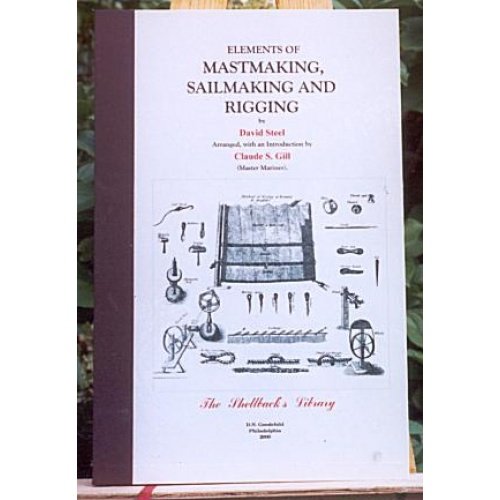
-
-
-
I came across these fairly recent additions to the US Navy Naval History & Heritage Command collections and thought some of you may find them of interest.
Crawford, Michael J. 2017. Officers of Peculiar Skill: Petty and Forward Officers of the U.S. Navy, 1797–1860. Washington, D.C: Naval History and Heritage Command.Corrected Link: https://www.history.navy.mil/content/dam/nhhc/research/publications/Peculiar Skill.pdf———. 2019. Sea Stories: Forays into American Naval History During the Age of Sail. Washington, D.C: Naval History and Heritage Command. -
14 minutes ago, bruce d said:
Thanks Wayne, see my edited text for boo-boo.
That may take some digging! Have you, by any chance, any of the editions of Laughton, L.G. Carr Old Ship Figureheads and Sterns London: Halton & Truscott Smith, LTD., 1925? I believe there is a recent (2006, 2012) Dover reprint available. The 1925 editions are rather pricey on the second hand market ranging from $60 to over $400. There may be a bit more history in there.
Good luck!
-
12 minutes ago, bruce d said:Simpson, George. 1914. The Naval Constructor: A Vade Mecum of Ship Design for Students, Naval Architects, Shipbuilders and Owners, Marine Superintendents, Engineers and Draughtsmen. New York, D. Van Nostrand Company; [etc., etc.]. http://archive.org/details/navalconstructor00simprich.



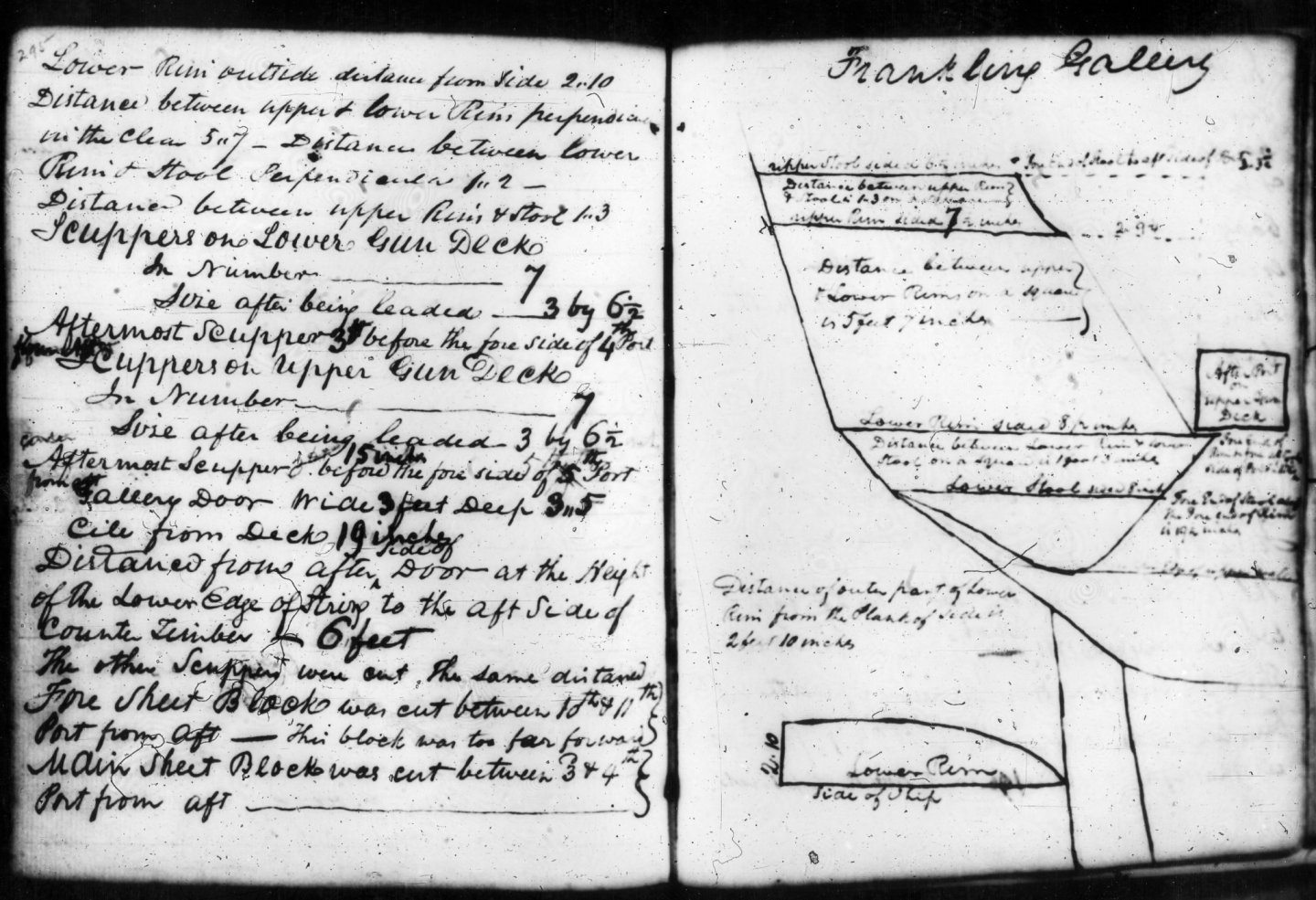

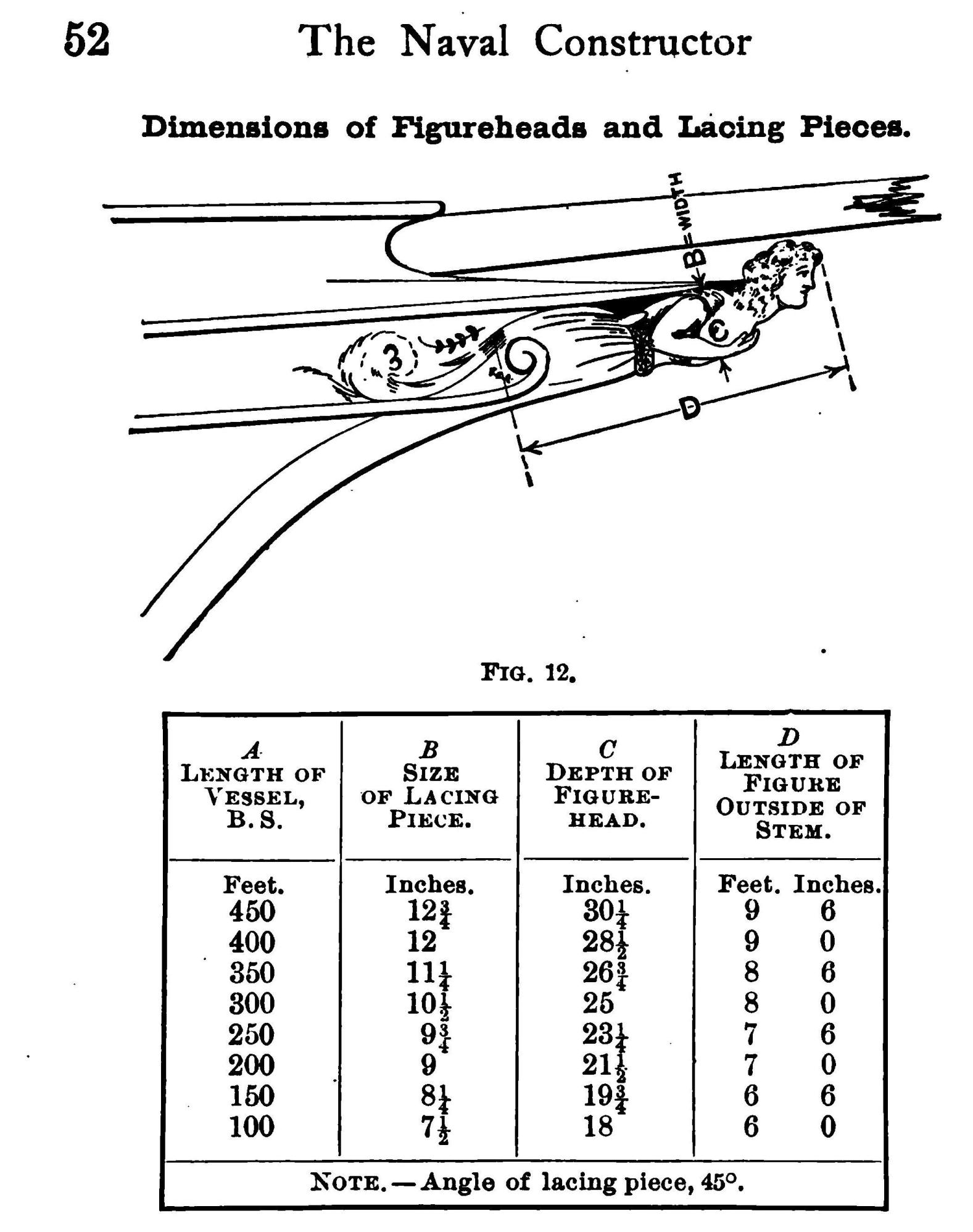
Period Ship Books Recommendations Needed
in Book, Monograph and Magazine reviews and Downloads. Questions and Discussions for Books and Pubs
Posted · Edited by trippwj
added additional information
As promised, here are a few resources on rigging of 17th Century vessels. I have tried to avoid duplicating anything from above.
The Davis (1711) was reprinted by the NRG in 1985 (editted by Merrit Edson). I have a pdf copy, but for the life of me I can not recall from whence it came!
See also this thread for some additional information. .